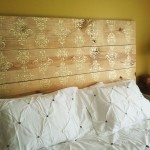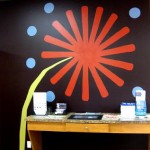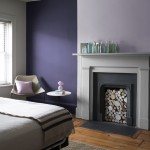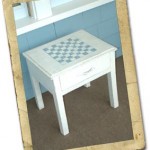 The other night, we–my family and I–were sitting in the living room, watching the Tigers. The kids were running around, driving us a little nuts and eventually there came a point when I stood up and put my hands on my hips. (Which really, is something I wish I didn’t do because my wife and kids always mock me and laugh and say that I think I’m a Super Hero. Which I don’t, the picture below notwithstanding. I just happen to stand like one.)
The other night, we–my family and I–were sitting in the living room, watching the Tigers. The kids were running around, driving us a little nuts and eventually there came a point when I stood up and put my hands on my hips. (Which really, is something I wish I didn’t do because my wife and kids always mock me and laugh and say that I think I’m a Super Hero. Which I don’t, the picture below notwithstanding. I just happen to stand like one.)
At any rate, I stood up, put my hands on my hips and said, “Alright! It’s time to brush your teeth!”
Caleb, my 10-year-old son, just snickered, nudged Andrew, his younger brother, and whispered in a too-loud whisper: “Look, Dad acting like he’s Superman again.”
I looked down and realized my hands were on my hips and my chest (or stomach) was all puffed out. All I really

Proof that I have a tendency to stand like a superhero.
lacked was a cape and tights. And muscles. And height.
I thought for a second about how sad a Super Hero I would actually make before returning to the issue at hand: “Go! Go brush your teeth. It’s time for bed.”
Well, they scampered off–all 5 of them–like a small heard of domesticated beasts. But amidst the thundering of their stampede, I heard something I couldn’t believe: I heard Andrew–in confidential and extremely boastful tones–say the following:
“I haven’t brushed my teeth in four days!”
To which Caleb responded with: “Wow. How do you get away with it?”
To which Andrew replied, “I fake it.”
Well, at that point, I’d heard enough. The last thing I need with 5 kids is for Andrew to start promulgating a gospel of dental neglect. I stomped into the room, stood with my feet shoulder-length apart, straightened my back, puffed out my chest (or stomach), put my hands on my hips and said:
“Andrew Peter! You will brush your teeth at least twice a day or…or…” I searched and searched for the right threat, the right punishment, the right ultimatum to level at this hygiene-negligent son of mine. Ah, yes, that will do. “Or, you will pay your own dental bills!”
Andrew’s face clouded over and he looked down in defeat. Then, he looked back up. “Where am I going to get money for all of that? I’m just a kid.”
What? Money for…? He was trying to get me off-topic. “It doesn’t matter where the money comes from,” I said. “I’m saying you’ll have to find it and pay the dentist for all the bills that you rack up because you don’t brush your teeth.”
There. A definitive closing argument. Now, we should be able to move on.
“You mean ‘pay him’ like when I pay at the restaurant? When you give me money and I pay? Like that?”
His eyes were big and innocent and I couldn’t tell if he was really curious or if he was messing with me.
“No. Not like that. You’ll have to earn the money yourself.”
He paused. Looked down, thinking. Then his face brightened: “Dad, the only money I get comes when I get Tooth Fairy money. So if I’d lose all my teeth, I’d have enough money to pay the dentist, right?” I started to respond that that didn’t make any sense, but he kept rolling. “But then, I wouldn’t have any teeth to brush or any teeth to have to pay the dentist to drill, right?” He was picking up steam now, the clear end of his logical masterpiece in sight. “So then, I’d have all the money and I wouldn’t have anything to pay the dentist for and, I wouldn’t have teeth to brush. I’d be rich.” He finished with a flourish and I half-expected the other kids to rise to their feet, clapping.
I needed to end this and I needed to end it now. I puffed out my chest one more time, struck my pose and said, “Brush your teeth” in a very no-nonsense kind of way.
Caleb, who’d watched the whole exchange, snickered and said, “Superman has spoken–we must obey.”
Well, that kind of broke the ice and we all laughed a little bit. But I couldn’t shake Andrew’s desire to not brush his teeth. I mean really, who intentionally tries to avoid brushing their teeth? Who else but a kid would ignore such a simple project–especially when ignoring that project is only going to lead to expensive and painful work down the road?
I was just thinking those thoughts when the home improvement point hit me (yes, I’ve written enough blogs and radio segments about paint to see paint-related points in everything): I’m doing the same thing he is–with the exact same consequences.
See, there are all sorts of little projects around my home. A hallway ceiling that should be painted. Kitchen cupboards that need to be touched-up. Some peeling edges on my wallpaper that should be stuck back down.
I’ve got all kinds of little projects. Some are bigger than others, but most are really, just 10 and 15 minute jobs. In the grand scheme of things, they take no time at all. They cost almost nothing and they don’t require loads of expertise or special tools.
And yet I routinely ignore them. I do. I don’t know why. I guess I’m like Andrew–I don’t want to take the time to do these little fixes. I just keep telling myself that it’s not a big deal, that I’ll get to it later.
But the problem with that line of thought is that failure to act now only causes bigger problems later. Just like Andrew and his teeth, I’m saving time now, but I’m going to have to pay the piper, later. And I’ll have to use my own money to do it.
For example, the peeling wallpaper is a perfect case in point. The spot I needed to fix was about 3 inches long all along a seam. Nothing. It wouldn’t have taken any time or money or effort at all. (Notice I’ve shifted to past-tense to talk about this). A little dab of paste, some safe-release tape to hold it down for a few hours and it would have looked like new. But I left it and didn’t do it. I ignored it.
But Tessa didn’t. She found it and, of course, figured it should be picked at, peeled, pulled at. Well, one thing led to another and before long, she’d created a much bigger problem that took much longer to fix. On top of it all, the fix I managed to come up with wasn’t nearly as effective as the easier, cheaper one would have been.
So now, that’s me and my family–what’s your’s like? Are your kids brushing their teeth? If not, do they brag about it, too? Is that just a kid-thing? Or do I have bad-hygiene kids? And how about you? Not so much your teeth, but do you have projects at home like I do? Easy, quick projects you keep ignoring?
Well, maybe it’s time to tackle them. Maybe it’s time to cross them off your list and deal with them on a more regular basis–before they become bigger, more expensive problems down the road.
Give it some thought!
 Here’s a great idea from a blog we follow called Simply Sjostedt. It’s a simple way to create an entirely unique, interesting, headboard using only some planks, a stencil and some paint.
Here’s a great idea from a blog we follow called Simply Sjostedt. It’s a simple way to create an entirely unique, interesting, headboard using only some planks, a stencil and some paint.


 The other night, we–my family and I–were sitting in the living room, watching the Tigers. The kids were running around, driving us a little nuts and eventually there came a point when I stood up and put my hands on my hips. (Which really, is something I wish I didn’t do because my wife and kids always mock me and laugh and say that I think I’m a Super Hero. Which I don’t, the picture below notwithstanding. I just happen to stand like one.)
The other night, we–my family and I–were sitting in the living room, watching the Tigers. The kids were running around, driving us a little nuts and eventually there came a point when I stood up and put my hands on my hips. (Which really, is something I wish I didn’t do because my wife and kids always mock me and laugh and say that I think I’m a Super Hero. Which I don’t, the picture below notwithstanding. I just happen to stand like one.)

 By Guest Writer, Shannon VandenBosch
By Guest Writer, Shannon VandenBosch
 It’s been a while since we tossed up a “quick hitter” project–a project that should take you less than a couple hours and cost you less than $40–so I thought I’d pitch this one to you: painting an accent wall.
It’s been a while since we tossed up a “quick hitter” project–a project that should take you less than a couple hours and cost you less than $40–so I thought I’d pitch this one to you: painting an accent wall.

 Painting a checkerboard design on a table is a great project that will infuse your front porch (or wherever) with that old-fashioned, laid- back feeling we all associate with a game of checkers. It’s simple, quick and best of all, will probably cost you less than $20 (including the table).
Painting a checkerboard design on a table is a great project that will infuse your front porch (or wherever) with that old-fashioned, laid- back feeling we all associate with a game of checkers. It’s simple, quick and best of all, will probably cost you less than $20 (including the table). 2. Paint the Table (if necessary)
2. Paint the Table (if necessary) roll of safe-release masking tape available at your local home center or hardware store. Purchase the roll in the width that you drew your squares. (If you drew 2″ squares, go with the 2″ tape, etc.) Tape around the edges of the entire board and then tape off alternating lines and alternating squares (see inset).
roll of safe-release masking tape available at your local home center or hardware store. Purchase the roll in the width that you drew your squares. (If you drew 2″ squares, go with the 2″ tape, etc.) Tape around the edges of the entire board and then tape off alternating lines and alternating squares (see inset). 3e touch, or you can leave this part of the project for another day. Just use light pressure with some 150 grit sandpaper and dust over the entire surface of the table. Continue this until the checker board pattern is sufficiently distressed. Wipe the table clean with a slightly damp rag and, when it’s dry, either leave it as is or apply a single coat of a flat polyurethane varnish or a spray lacquer. (Be advised, unless you use a water-based polyurethane or a non-yellowing lacquer, this protective coat will yellow slightly over time.)
3e touch, or you can leave this part of the project for another day. Just use light pressure with some 150 grit sandpaper and dust over the entire surface of the table. Continue this until the checker board pattern is sufficiently distressed. Wipe the table clean with a slightly damp rag and, when it’s dry, either leave it as is or apply a single coat of a flat polyurethane varnish or a spray lacquer. (Be advised, unless you use a water-based polyurethane or a non-yellowing lacquer, this protective coat will yellow slightly over time.)
 I drive an old car. An OLD car. It’s a 1996 Chevy Cavalier. It’s purple. It used to be my wife’s. And yet, even though it has all that going against it–even though it’s probably one of the least “manly” cars you’re likely to see on the road–I continue to drive it. The reasons? It’s paid for and it continues to run.
I drive an old car. An OLD car. It’s a 1996 Chevy Cavalier. It’s purple. It used to be my wife’s. And yet, even though it has all that going against it–even though it’s probably one of the least “manly” cars you’re likely to see on the road–I continue to drive it. The reasons? It’s paid for and it continues to run.